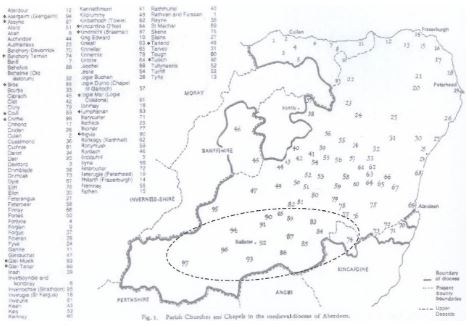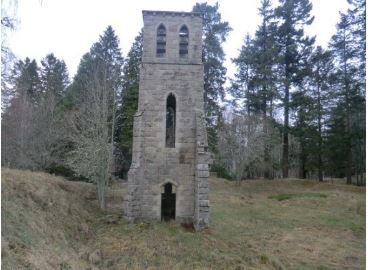Article 3
Article 3
This third of a series of articles by Hugh Cochran continues to look at the Diocese of Aberdeen as it was in 1560 and looks at the five churches from Tullich westwards to Kindrochit in Braemar.
The five pre Reformation churches at the very west end of our Diocese have their own history, but unfortunately very little of it is known to us. None of them stands in what is now a centre of population and two of them have vanished without trace. The others form melancholy ruins in now deserted sites.The population changes and improvement ideas of the 18th Century completely altered the pattern of the 16th and 17th centuries. When Francis Farquharson of Monaltrie returned from London in the 1760’s having been pardoned for his part in the Jacobite rising of 1745 he brought with him plans and ideas which would do away with the necessity for the churches at Tullich, Abergairn, and Glenmuick and he created the New Town of Ballater where no settlement yet existed, and his plan included the building of a new Church to be called Glenmuick Church in the central Square of the new town. That church still stands today while its predecessors have either disappeared or are abandoned. Incidently, the main object of the creation of the |New Town, started in the 1790’s, was to service the holiday Spa at Pannanich Wells, soon to be patronised by Lord Byron. In designing the New Town he created a Grid Iron development still evident on the ground, which predates the similar, but larger, Grid Iron development in New York City as laid out in the New York Commissioners’ Plan of 1811.

Tullich Church stands at OS Map Reference NO391975 which is about 1.5 miles before you reach Ballater on the main North Deeside road from Aboyne on the left, between the road and the river Dee. Around it, mostly on the other side of the road stood the settlement of Tullich of which no original houses remain, but the outline of the settlement can be seen. The township is famous for having given its name to the Reel of Tullich, a dance composed by the parishioners one day when the Minister was late for the service, and they performed this dance for the first time to keep themselves warm. Whether true or not, this anecdote clearly originates from post Reformation times, from the use of the term Minister.
The Church that stands there today was built about 1400 on the site of an earlier chapel said to have been built by St Nathallan in the 7th Century. Whatever church was there before 1309 was appropriated along with the churches at Aboyne, Towie and Maryculter to the Knights Templar at Maryculter, and on their suppression in 1309 to the Knights Hospitalers at Torphichen. There is also some evidence that Tullich was a chapel of the church at Aboyne, though it is not at all clear what that meant. If the church was appropriated to the Knights Hospitallers at the time of the Reformation, we can be fairly sure that it was not a wealthy church. All its revenue will have gone to the Hospitallers, and they will have repaid as little as possible to service a Vicar and for maintenance



Glenmuick on the other hand is not known to be associated with any saint. And then there are the ruins. There are substantial ruins of Abergairn which are near the point where the river Gairn joins the river Dee and can be reached either by car by taking the steep turn down from the main road just before it crosses the Gairn Bridge, or more interestingly by walking westward along the path from Ballater Railway Station along the track prepared for the railway which was never built. But there are no visible ruins of Glenmuick church. There are however ruins of a 19th century church at the above map reference number in Glenmuick. This was built by the laird of House of Glenmuick about one kilometre from the house, The present church has been demolished except for the tower and stands in a wood about 200 yards to the left (or south) of the road up Glenmuick. No ruins of any previous church are visible but if a 19th century laird wanted to build a church near his house, what better place to choose than the site of a previous redundant church?
Abergairn Church standing at OS Map Reference NO353969, and Glenmuick Church at OS Map Reference NO365 945 can be dealt with together because they have much in common. In common, they both served the glens of the rivers that join the Dee at Ballater. They both became redundant when the new Glenmuick Church was built in the Square at Ballater. And they were both appropriated to the hospital of St Germains in East Lothian. Founded in 1219 the church of Glen Muick and its chapel of Abergerny (Abergairn), which appear to have been in the patronage of the Knights of St John of Jerusalem in England, had by 1418 passed to the Bethlehamite Hospital of St Germains to which the revenues were appropriated. From there they passed in turn to King’s College, Aberdeen when the hospital and its resources were Abergairn Church today The 19th Century Tower at Glenmuick annexed to the college in 1496. The two churches differ however in two respects. Abergairn has a strong association with St Kentigern otherwise known as St Mungo the patron saint of Glasgow and is believed to have been dedicated to him.


Old Crathie Kirk can be found at OS map reference NO264943. This church stands between the main North Deeside road and the river and is reached by taking a left turn as you drive westwards just before the river bridge to Balmoral. It was built in the 13th century and abandoned in c1800. It led a quiet life all its working existence, its whole fruits being appropriated to Cambuskenneth Monastery since before 1347. The name of St Manire, who died in 824 AD is connected with this church. He was one of the last evangelising saints on Deeside and is believed to have been a successor of St Drostan at Deer Abbey. His main area of activity is thought to have been Upper Deeside where he established a church and was buried in it. His name is commemorated in the pool of the River Dee opposite Balmoral Castle called pollmanire.
Kindrochit Church is believed to have stood at OS map reference NO 154912. Kindrochit Castle is well documented and its ruins are clearly visible not far from the centre of Braemar overlooking the Falls of Clunie between St Margaret’s Episcopal Church and the river. Kindrochit Church however is less well known. No ruins are visible, and after local enquiry from an archaeologist, an architect, and a local historian, no one could be found who knew of the church’s position or even of its existence. However, it is listed by Ian B Cowan as one of the churches in the Diocese at the Reformation and along with the churches at Alford, Keig, and Leochel, paid its revenue to the Priory at Monymusk and the Abbey at Deer from c1400. Medieval churches were often sited near a castle, and the explanation for the absence of any ruins of the church is almost certainly that it was sited where St Margaret’s Church now stands. The photograph attached shows Kindrochit Castle ruins from across the river with St Margaret’s Church in the background.
© Hugh Cochran 2014
Discover more…
